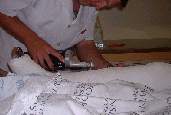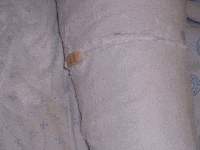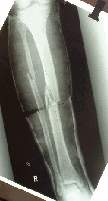| |
 |
 |

|
 |
 Department
of Orthopaedic Surgery
Department
of Orthopaedic Surgery
Stellenbosch University
|
 |

|
 |

|
 |
 |

|
 |
 Plaster
Casts and Splints Plaster
Casts and Splints |
 |

|
 |

|
Windows in casts
There are times when it is necessary to inspect wounds
under casts, and making windows to do so seems reasonable.
If at the time of cast application such a window is known
to be necessary, it is a good plan to apply a large bolus
of dressings over the wound, so that it sticks out. One may
then take a sharp knife and cut around the periphery of
this wad, leaving an oval hole. A rectangular hole cut with
a saw makes the cast weak, because the corners act as
stress risers. The cast might reasonably be reinforced by a
dorsal fin to make up for the weakness of the open section.
If the window is made to inspect a wound - plaster it
closed again after the inspection to avoid a fracture in
your cast. If a tibial wound needs regular access eg a skin
graft or flap over a open fracture consider an alternative
to a window such as exoskeletal fixation.
Windows in casts are hazardous if left open, especially
if there is any tendency for the limb to swell. The soft
tissue may herniate through the hole, becoming grossly
edematous, and the skin tends to break down from the
pressure produced by the margins of the defect. To avoid
this complication, we generally cut a piece of felt or
sponge rubber to the size of the hole and bandage this
snugly in place over the dressings with an elastic bandage
to provide uniform compression.
Wedging of a cast
After an attempted closed reduction and the application of
a circular cast, there may be some residual varus or valgus
angulation or posterior bow. Under these circumstances, it
is quite permissible to make a transverse cut two thirds of
the way around the cast (leaving a hinge opposite the
convexity of the angulation)
 |
| Angulated
Fracture |
 |
|
Cutting the POP
|
and open up the cut until the angulation is adequately
corrected. The cut edges of the cast must then be everted
with molders, or, if these are not available, pliers.
Little blocks of wood or corks to are placed hold the wedge
open. Make sure these do not exert pressure on the
unserlying skin. We generally pack some sheet wadding in
the defect and repair the cast while holding the limb in
the corrected position. To gain the greatest mechanical
advantage, the wedge should be made at the point where the
central long axes of both fragments intersect; this point
can be ascertained by drawing the appropriate lines on the
x-ray film. Wedging can correct angulation but not
shortening or rotation. We find the greatest use for
wedging in fractures of the tibia, where the correction
tends to be comparatively small. If large corrections are
to be made, a combination of an opening wedge on the
concave side and closing wedge on the convex side is safer,
because a large opening wedge will elongate the cast and
apply undue pressure on the dorsum of the foot. However, if
large corrections are necessary, we usually apply a new
cast.
 |
|
Cast is corrected to predetermined angle
|
 |
Post reduction
X-ray
|
Splitting a plaster cast
A cast is rigid and cannot compensate for swelling of the limb.
If there is any danger of swelling ie most fresh fractures the cast must be split.
Avoid circular casts in fresh fractures about the elbow and knee
- rather use an back-slab as the initial plaster.
Technique
Use a plaster saw or shears to split the cast( and cut through all
padding too). In a forearm fracture make the cut on the Ulnar border.
If loss of reduction is feared after the swelling subsides the cut can be
railroaded. (a 25 mm track is cut out) A week later a bandage can be applied
over the plaster to compress it over the shrunken limb.
|
|


